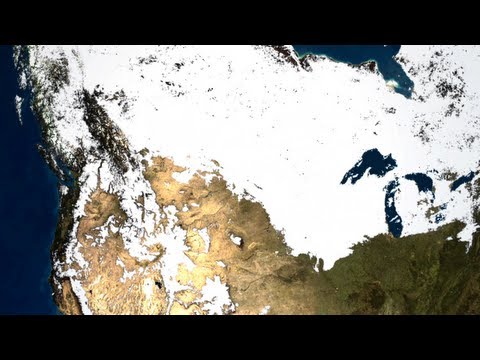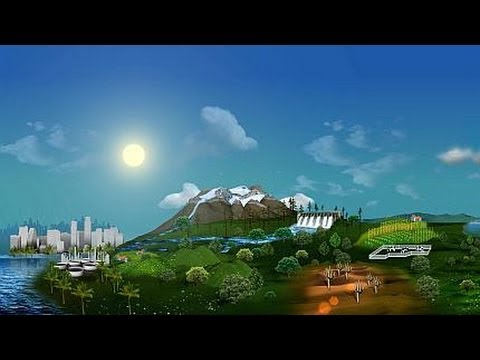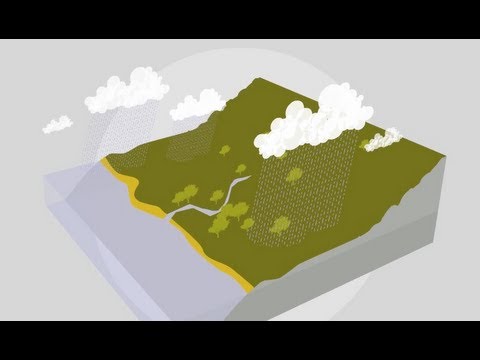8.2: Distribution of Earth’s Water
- Page ID
- 12828
Earth’s oceans contain 97% of the planet’s water, so just 3% is fresh water, water with low concentrations of salts. Most fresh water is trapped as ice in the vast glaciers and ice sheets of Greenland. A storage location for water such as an ocean, glacier, pond, or even the atmosphere is known as a reservoir. A water molecule may pass through a reservoir very quickly or may remain for much longer. The amount of time a molecule stays in a reservoir is known as its residence time.Earth’s oceans contain 97% of the planet’s water, so just 3% is fresh water, water with low concentrations of salts. Most fresh water is trapped as ice in the vast glaciers and ice sheets of Greenland. A storage location for water such as an ocean, glacier, pond, or even the atmosphere is known as a reservoir. A water molecule may pass through a reservoir very quickly or may remain for much longer. The amount of time a molecule stays in a reservoir is known as its residence time.

Three States of Water
Because of the unique properties of water, water molecules can cycle through almost anywhere on Earth. The water molecule found in your glass of water today could have erupted from a volcano early in Earth history. In the intervening billions of years, the molecule probably spent time in a glacier or far below the ground. The molecule surely was high up in the atmosphere and maybe deep in the belly of a dinosaur. Where will that water molecule go next?Water is the only substance on Earth that is present in all three states of matter – as a solid, liquid or gas. Along with that, Earth is the only planet where water is present in all three states. Because of the ranges in temperature in specific locations around the planet, all three phases may be present in a single location or in a region. The three phases are solid (ice or snow), liquid (water), and gas (water vapor).

The Water Cycle
Because Earth’s water is present in all three states, it can get into a variety of environments around the planet. The movement of water around Earth’s surface is the hydrologic (water) cycle.The Sun, many millions of kilometers away, provides the energy that drives the water cycle. Our nearest star directly impacts the water cycle by supplying the energy needed for evaporation.Most of Earth’s water is stored in the oceans where it can remain for hundreds or thousands of years. The oceans are discussed in detail in the chapter Earth’s Oceans.
Water changes from a liquid to a gas by evaporation to become water vapor. The Sun’s energy can evaporate water from the ocean surface or from lakes, streams, or puddles on land. Only the water molecules evaporate; the salts remain in the ocean or a freshwater reservoir. The water vapor remains in the atmosphere until it undergoes condensation to become tiny droplets of liquid. The droplets gather in clouds, which are blown about the globe by wind. As the water droplets in the clouds collide and grow, they fall from the sky as precipitation. Precipitation can be rain, sleet, hail, or snow. Sometimes precipitation falls back into the ocean and sometimes it falls onto the land surface.

When water falls from the sky as rain it may enter streams and rivers that flow downward to oceans and lakes. Water that falls as snow may sit on a mountain for several months. Snow may become part of the ice in a glacier, where it may remain for hundreds or thousands of years. Snow and ice may go directly back into the air by sublimation, the process in which a solid changes directly into a gas without first becoming a liquid. Although you probably have not seen water vapor sublimating from a glacier, you may have seen dry ice sublimate in air.
Snow and ice slowly melt over time to become liquid water, which provides a steady flow of fresh water to streams, rivers, and lakes below. A water droplet falling as rain could also become part of a stream or a lake. At the surface, the water may eventually evaporate and reenter the atmosphere.
A significant amount of water infiltrates into the ground. Soil moisture is an important reservoir for water. Water trapped in soil is important for plants to grow. Water may seep through dirt and rock below the soil through pores infiltrating the ground to go into Earth’s groundwater system. Groundwater enters aquifers that may store fresh water for centuries. Alternatively, the water may come to the surface through springs or find its way back to the oceans. Plants and animals depend on water to live and they also play a role in the water cycle. Plants take up water from the soil and release large amounts of water vapor into the air through their leaves, a process known as transpiration. NASA has an excellent online guide of the hydrologic cycle.People also depend on water as a natural resource. Not content to get water directly from streams or ponds, humans create canals, aqueducts, dams, and wells to collect water and direct it to where they want it.
| Use | United States | Global |
|---|---|---|
| Agriculture | 34 percent | 70 percent |
| Domestic (drinking, bathing) | 12 percent | 10 percent |
| Industry | 5 percent | 20 percent |
| Power plant cooling | 49 percent | small |
The table above displays water use in the United States and globally (Estimated Use of Water in the United States in 2005, USGS). It is important to note that water molecules cycle around. If climate cools and glaciers and ice caps grow, there is less water for the oceans and sea level will fall. The reverse can also happen.
- Dynamic Earth: Introduction to Physical Geography. Authored by: R. Adam Dastrup. Located at: http://www.opengeography.org/physical-geography.html. Project: Open Geography Education. License: CC BY-SA: Attribution-ShareAlike
- MeanMonthlyP. Authored by: PZmaps. Located at: https://en.Wikipedia.org/wiki/File:MeanMonthlyP.gif. License: CC BY-SA: Attribution-ShareAlike
- NASA | Earth's Water Cycle. Authored by: NASA Goddard. Located at: https://youtu.be/oaDkph9yQBs. License: All Rights Reserved. License Terms: Standard YouTube License
- The Water Cycle. Authored by: National Science Foundation. Located at: https://youtu.be/al-do-HGuIk. License: All Rights Reserved. License Terms: Standard YouTube License
- How does the water cycle work?. Authored by: Met Office - Weather. Located at: https://youtu.be/SvA11IuweNk. License: All Rights Reserved. License Terms: Standard YouTube License
- Distribution of Earth's Water. Provided by: USGS. Located at: http://water.usgs.gov/edu/watercyclesummary.html. License: Public Domain: No Known Copyright
- Water cycle. Provided by: USGS. Located at: https://commons.wikimedia.org/wiki/File:Water_cycle.png. License: Public Domain: No Known Copyright




